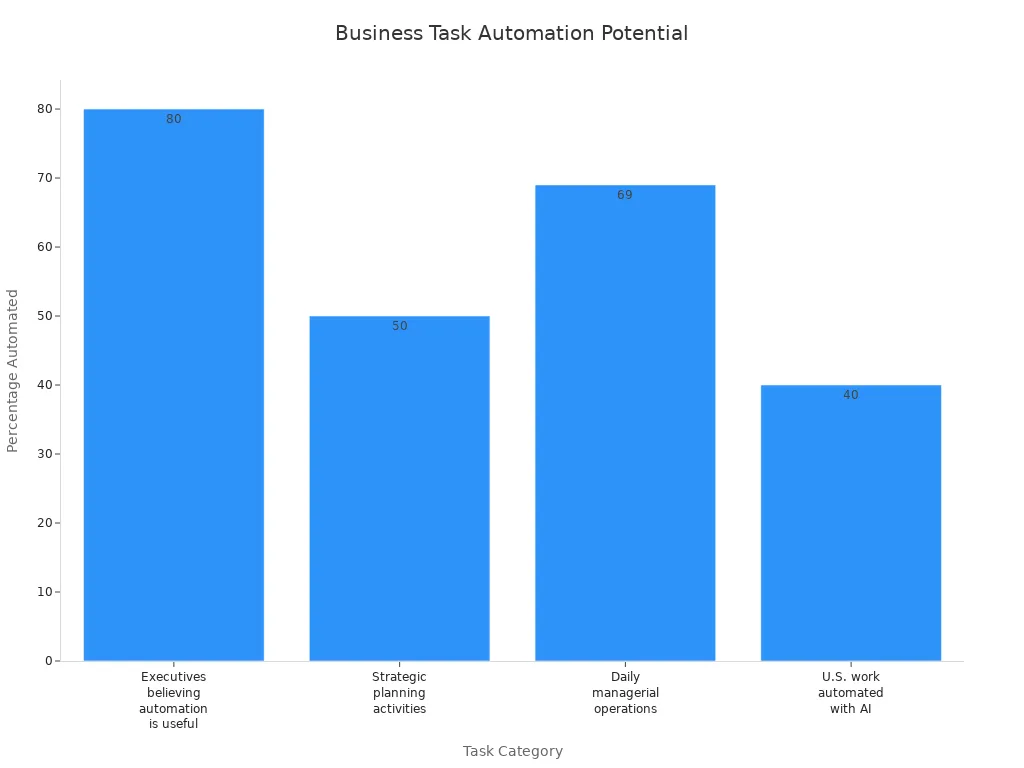Business Management Systems bring simple solutions to your business

Business Management Systems help companies solve everyday problems with simple solutions. These systems improve how teams manage resources, clients, and customers.
Streamlining business processes makes complex workflows easier to handle.
Improved resource management leads to better product development quality.
Strong communication helps businesses adapt quickly when markets change.
A company can boost efficiency and growth by using a system that organizes tasks and automates routine work. Leaders should consider how their current processes compare to the benefits of a modern BMS.
Key Takeaways
Business Management Systems (BMS) simplify complex workflows, making it easier for teams to manage tasks and resources.
Centralized data improves decision-making by providing a single source of truth, reducing errors and enhancing efficiency.
Automation of routine tasks saves time, allowing employees to focus on more important work and boosting overall productivity.
Effective communication through BMS fosters teamwork, reduces misunderstandings, and enhances project outcomes.
Choosing the right BMS involves evaluating current processes, defining business needs, and ensuring stakeholder involvement.
Investing in training and support increases team adoption of BMS, leading to better results and smoother transitions.
BMS can lead to significant cost savings by reducing paperwork, improving time management, and optimizing resource use.
Scalable BMS solutions help businesses grow without sacrificing quality or efficiency, supporting long-term success.
What Are Business Management Systems?
Simple Definition
A Business Management System is a collection of tools, processes, and technologies that help organizations organize, manage, and track their operations. Industry standards define a management system as the method by which a company manages its interrelated business components to achieve specific objectives. These objectives often include quality, efficiency, and compliance with regulations. The system's complexity depends on the organization's needs. Some companies require extensive documentation and controls, while others use simpler frameworks.
A formal management system exists when a company has clearly defined, documented, and actively managed processes. These processes must cover all business activities without gaps or overlaps. This approach ensures that every part of the business works toward the same goals.
Core Purpose
The main purpose of Business Management Systems is to help organizations reach their objectives by improving how they operate. These systems provide a framework for managing daily tasks, planning, and implementation. They also support quality, efficiency, and compliance.
Key components of a Business Management System include:
Process management
Quality management
Resource management
Risk management
Performance monitoring
Each component plays a role in optimizing operations and increasing efficiency. For example, process management helps standardize workflows, while performance monitoring tracks progress toward goals. Companies use these systems to align their activities with business objectives and to ensure that all teams follow the same standards.
Note: Business Management Systems often outperform traditional management methods. They structure organizations around processes instead of departments. This structure leads to better execution, accountability, and proactive performance measurement.
Types
Many types of Business Management Systems exist to meet different business needs. Companies can choose from a wide range of software and tools. Some popular types include:
Scheduling software
Payment processing software
Communication software
Automation software
Accounting software
CRM (Customer Relationship Management) software
Enterprise Resource Planning (ERP) software
Project management software
Marketing automation software
Inventory management software
Ecommerce software
Tax software
Human Resources Management (HRM) software
Data management and analytics software
Cybersecurity software
Comprehensive solutions like Zoho One combine several of these tools into a single platform. This integration allows businesses to manage planning, daily procedures, and reporting from one place.
Description | |
|---|---|
Planning and preparation | Define integration goals and analyze current systems for a smooth process. |
Choosing the right tools | Evaluate tools, prioritize cloud solutions, and ensure security during integration. |
Scalability considerations | Select scalable designs to support future growth. |
Testing and verification | Test thoroughly to ensure accuracy and reliability. |
Continuous improvement | Gather feedback and adapt strategies as business needs change. |
Business Management Systems help companies adapt to growth and changing technology. They also improve decision-making by providing a complete view of operations.
Centralized Data

Centralized data plays a vital role in modern organizations. It brings together information from different departments and systems, creating a single source of truth. This approach helps companies make better decisions and operate more efficiently.
Unified Access
When a company uses centralized data, employees can access the information they need from one location. This unified access improves workflow and reduces the time spent searching for files or reports. Teams work faster because everyone uses the same data set. Managers see real-time updates and can track progress without waiting for manual reports.
Centralized data supports quick decision-making. 79% of enterprise executives believe that companies not adapting to big data will be left behind. Businesses with a proper data management plan are twice as likely to achieve their objectives compared to those without.
A centralized system also helps new employees learn processes faster. They find all necessary documents and resources in one place. This structure encourages collaboration and keeps everyone on the same page.
Fewer Errors
Centralized data storage creates a unified and accurate source of information. All departments access the same reliable data, which minimizes duplication and discrepancies. Employees work with consistent information, reducing mistakes in reports and transactions.
By maintaining consistency across all data points, centralized data management enhances reliability throughout an organization's operations. When the entire company uses a platform as a single source of truth, it eliminates data discrepancies and duplication. This approach increases data access and adoption across all business areas.
Centralized data reduces errors, which can cost organizations an average of $12.9 million per year due to poor data quality.
Businesses with centralized data are twice as likely to achieve their objectives.
Reliable data improves operational efficiency and supports better decision-making.
Data Security
Protecting sensitive information is a top priority for every organization. Business Management Systems use advanced security protocols to keep data safe.
Advanced Encryption Standard (AES) with a 256-bit key protects data at rest and in transit.
Encryption covers all types of data, including data at rest, in transit, and in use.
Data loss prevention (DLP) systems monitor and restrict access to sensitive data.
Firewalls isolate networks and block unauthorized access.
Business Management Systems also help companies comply with industry regulations. They provide structured frameworks for documenting policies and automating compliance processes. Real-time monitoring of regulatory changes enables organizations to adapt quickly. Centralizing compliance processes reduces human error and speeds up response times.
Centralized data ensures that only authorized users access sensitive information. Security measures protect against threats and keep customer data confidential.
Task Automation

Routine Processes
Many businesses rely on routine tasks to keep operations running smoothly. These tasks include scheduling meetings, sending invoices, updating records, and managing inventory. Business Management Systems automate these processes, allowing employees to focus on more important work. Automation reduces manual effort and increases accuracy.
Executives recognize the value of automation. A recent survey shows that 80% of executives believe automation is useful for their organizations. Strategic planning activities can be automated by up to 50%. Daily managerial operations have an automation potential of 69%. In the United States, 40% of work can be automated with artificial intelligence.
Statistic Description | Percentage |
|---|---|
Executives believing automation is useful | 80% |
Estimated automation of strategic planning activities | 50% |
Daily managerial operations expected to be automated | 69% |
Work in the U.S. that can be automated with AI | 40% |

Automated systems handle repetitive tasks without errors. Employees no longer need to enter data by hand or check spreadsheets for mistakes. This shift leads to more reliable results and fewer delays. Teams can trust the system to complete tasks on time.
Automation helps companies avoid costly mistakes. Reliable systems ensure that every step follows the correct procedure.
Time Savings
Automating routine processes saves valuable time for employees and managers. Studies show that 60% of employees could save 30% of their time with workflow automation. Many workers spend at least two hours each day on repetitive tasks. Automation frees up this time, allowing staff to focus on strategy and creativity.
Source | Evidence |
|---|---|
McKinsey | 60% of employees could save 30% of their time with workflow automation. |
Docuclipper | 51% of employees spend at least two hours daily on repetitive tasks. |
Employees use their extra time to solve problems, develop new ideas, and improve customer service. Managers analyze data and make better decisions. Companies see faster project completion and higher productivity.
Automated systems also help teams respond quickly to changes. When a new task appears, the system assigns it and tracks progress. Everyone knows what to do and when to do it. This approach keeps projects moving forward.
Time saved through automation leads to greater efficiency and growth. Companies that automate routine work gain a competitive advantage.
Communication & Collaboration
Team Connection
Strong team connection forms the backbone of any successful business. Business Management Systems help teams communicate more clearly and efficiently. When teams understand each other's roles and responsibilities, they can plan and manage time better. Clear communication ensures everyone knows deadlines, tasks, and priorities. This understanding leads to better project planning and fewer delays.
Effective communication enhances understanding of deadlines, tasks, and priorities, leading to improved planning and time management.
Clear communication reduces the risk of misunderstandings that can inflate project budgets due to errors or rework.
The quality of the final product improves when the technical team comprehends customer expectations, preventing errors and fostering innovative solutions.
Customer satisfaction increases as open communication builds trust and a sense of shared responsibility among team members.
Teams that use these systems avoid confusion and costly mistakes. They also build trust and a sense of shared responsibility. When everyone stays informed, the team can deliver higher-quality results and meet customer expectations. Open communication helps teams solve problems quickly and encourages creative solutions.
Tip: Teams that communicate openly often find it easier to adapt to changes and overcome challenges together.
Real-Time Sharing
Real-time sharing allows teams to work together without delays. Business Management Systems provide tools for instant updates and information sharing. Team members can see changes as they happen, which keeps everyone on the same page. This approach reduces the risk of miscommunication and helps teams respond quickly to new tasks or issues.
Benefit | Description |
|---|---|
Synchronized Interaction | Enables seamless communication and collaboration among team members on various projects and tasks. |
Transparency | Creates an open environment where all team members can access and share information easily. |
Increased Productivity | Facilitates simultaneous collaboration, reducing misunderstandings and streamlining workflows. |
Instant Access | Provides real-time updates, allowing teams to identify bottlenecks and track progress effectively. |
Minimized Miscommunication | Ensures everyone is informed and aligned, reducing the risk of miscommunication among team members. |
With real-time sharing, teams can track progress and spot problems early. Everyone has access to the latest information, which helps them make better decisions. This transparency supports a culture of accountability and teamwork. Teams that collaborate in real time often finish projects faster and with fewer errors.
Note: Real-time sharing tools help teams stay connected, even when working from different locations.
Reporting & Insights
Data Access
Business Management Systems give companies powerful tools for reporting and insights. These systems collect data from many sources and organize it in one place. Employees can find the information they need quickly. Managers use this data to track progress and measure results.
Most Business Management Systems offer several types of reports. Each type serves a different purpose and helps teams understand business performance. The table below shows common reporting features:
Type of Report | Description |
|---|---|
Analytical reports | Involves examining and assessing the effectiveness of business strategies. |
Internal reports | Prepared within a business to relay the performance of plans or projects within departments. |
Operational reports | Monitors performance of business metrics to optimize performance, identify trends, minimize costs, and improve operations. |
Analytical reports help leaders see if their strategies work. Internal reports show how departments perform. Operational reports track daily activities and spot trends. With these tools, companies can respond to problems faster and find new opportunities.
Tip: Easy access to accurate reports helps teams stay informed and make better choices every day.
Better Decisions
Accurate insights lead to better decisions. Business Management Systems improve the quality of insights in several ways:
Rigorously testing hypotheses helps ensure the reliability of insights, which is crucial for accurate business decision-making.
Implementing controlled experiments or pilot studies allows for validation of assumptions, leading to more accurate insights.
Using multiple data sources prevents biases and inaccuracies, enhancing the overall quality of business insights.
When companies test their ideas and check results, they avoid costly mistakes. Using data from many sources gives a complete picture of the business. This approach helps leaders spot risks and plan for the future.
Teams use these insights to set goals, adjust strategies, and measure success. Reliable data supports every step, from daily tasks to long-term planning. Companies that use strong reporting tools often grow faster and adapt better to change.
Note: Good reporting and insights turn raw data into clear actions. This process gives businesses a strong advantage in a competitive market.
Business Management Systems Benefits
Productivity
Business Management Systems help organizations boost productivity by streamlining daily operations. Teams work more efficiently when they have access to real-time metrics and continuous feedback. Companies that use productivity management software often see an average increase of 20-30% in overall business productivity. Some organizations report double-digit improvements in employee productivity after adopting these systems. Digital technologies can increase productivity by up to 60%.
Real-time metrics help teams track progress and adjust quickly.
Continuous feedback models raise employee engagement rates.
Technology integration leads to productivity gains of up to 25%.
Clients at 'systems and teams' have experienced higher productivity by using centralized dashboards and automated workflows. Employees spend less time on repetitive tasks and more time on creative problem-solving. Managers monitor performance and provide feedback, which helps teams stay motivated and focused.
Teams that use Business Management Systems often complete projects faster and deliver better results.
Cost Savings
Business Management Systems reduce costs in many areas of business. Companies save money by cutting down on paperwork and print costs. Digital documentation lowers expenses related to printing and storing physical files. Efficient scheduling allows employees to focus on important work, which improves time management.
CRM tools help maintain customer relationships, reducing acquisition costs.
Inventory management systems minimize waste and lower costs from excess stock.
Data analytics tools support smart decision-making, helping businesses avoid costly mistakes.
Consolidating systems reduces licensing fees and IT overheads.
Integrated marketing tools prevent wasteful spending on ads.
User-friendly software lowers training and IT costs.
Faster invoicing improves cash flow and reduces late payments.
Centralized data provides insights that help leaders make informed decisions.
Clients at 'systems and teams' have optimized their operations by using integrated platforms. These platforms help businesses eliminate redundant systems and streamline workflows. Companies see lower overhead costs and improved cash flow, which supports long-term growth.
Cost savings allow businesses to invest in new opportunities and strengthen their competitive edge.
Scalability
Business Management Systems support scalability by helping companies grow without losing efficiency or quality. Many successful businesses have used these systems to expand their operations and reach new markets.
Business | Description |
|---|---|
Amazon | Evolved from an online bookstore to a global e-commerce and cloud computing giant. |
Airbnb | Disrupted the hospitality industry with a peer-to-peer lodging model. |
Netflix | Transitioned from DVD rentals to a leading streaming service. |
Salesforce | Leveraged cloud technology to revolutionize customer relationship management. |
Uber | Scaled from a ride-sharing app to a multi-service platform. |
Other companies, such as AYM Studio, Dollar Shave Club, and Amarra, have achieved significant growth by using AI tools and subscription models. These strategies allow businesses to handle more customers and transactions without increasing workload.
Clients at 'systems and teams' have scaled their businesses by adopting flexible management systems. These systems help companies manage larger teams, more products, and new markets. Leaders use centralized data and automation to maintain quality and efficiency as the business grows.
Scalable systems ensure that companies can expand while keeping operations smooth and reliable.
Measurable Outcome | Description |
|---|---|
Increased Efficiency | Eliminates redundancies and automates tasks, freeing resources for high-value activities. |
Enhanced Quality Control | Standards like ISO 9001 ensure products meet expectations, improving trust and reliability. |
Better Decision-Making | Access to real-time data empowers informed leadership decisions. |
Cost Reduction | Eliminating waste and improving workflows leads to significant cost savings. |
Regulatory Compliance | Structured systems make it easier to meet industry standards, reducing penalty risks. |
Improved Communication | Connects teams, creating transparency and better coordination. |
Scalability | Ensures operations can scale without sacrificing efficiency or quality. |
Customer Satisfaction | Enhanced processes and quality lead to better products and services, improving customer satisfaction. |
Revenue Increase | Companies using ISO 9001 report an average revenue increase of 9% post-implementation. |
Choosing a System
Selection Criteria
Selecting the right Business Management System requires careful analysis. Companies often start by reviewing their current processes and identifying areas for improvement. They define key business needs and validate these requirements with department leaders. This approach ensures that the chosen system supports long-term goals across all functions.
A well-chosen system should meet several important criteria:
Well-defined processes
Deployment speed
Scalability
Security
Integration capabilities
Mobile-friendliness
Product development outlook
Budget considerations
Companies benefit from involving stakeholders early in the selection process. This step helps align the system with business objectives and encourages buy-in from different departments.
Teams should also consider how the system will impact daily operations. A thorough process review helps identify gaps and ensures that the new solution fits existing workflows.
Easy Implementation
Implementing a Business Management System presents several challenges. Companies often face resistance to change, unclear requirements, and unexpected issues. Planning for hardware upgrades and ensuring data quality are essential steps. Flexibility helps teams adapt when new challenges arise.
Common challenges during implementation include:
Planning necessary hardware upgrades
Expecting the unexpected
Unclear requirements
Scope creep from new requests
Insufficient staff commitment
Support from leadership plays a critical role in successful implementation. Leaders must provide clear direction and resources. Teams should optimize current processes before migration and focus on the original goals. High-quality data migration ensures that the new system operates smoothly.
Tip: Companies that plan for future growth during implementation often see better returns on investment.
Ignoring distractions and focusing on execution helps teams stay on track. Regular reviews and adjustments keep the project aligned with business needs.
Team Adoption
High team adoption rates drive the success of any Business Management System. Successful companies appoint internal champions who guide others through the transition. Training and education ensure that everyone understands how to use the new tools.
Teams often benefit from incremental rollouts. Starting small allows staff to adjust and reduces resistance. Custom guidelines tailored to different roles help employees use the system effectively. Regular feedback sessions address concerns and improve the adoption process.
Appoint internal champions
Provide thorough training and education
Start with small incremental rollouts
Create custom guidelines for team roles
Solicit regular feedback
Ensure continued training for new features
Ongoing support and training keep teams updated and confident. Companies that invest in their people see higher adoption rates and better results.
A strong adoption strategy helps teams embrace new technology and unlock the full potential of their Business Management System.
Business Management Systems deliver simple, effective solutions that help organizations streamline operations, automate tasks, and improve communication. Companies see better results when they customize systems, invest in employee training, and ensure executive support. Recent research shows that competitive pressures drive businesses to adopt these systems for greater efficiency and growth. Before choosing a new system, leaders should evaluate current processes, define objectives, and monitor outcomes. For those seeking the best fit, consulting trusted resources or experts can provide valuable guidance. 📈 Reach out for more information or a personalized consultation.
FAQ
What is a Business Management System?
A Business Management System helps companies organize, track, and manage daily operations. It combines software tools and processes to improve efficiency and support business goals.
How does a BMS improve productivity?
A BMS streamlines workflows and automates routine tasks. Teams spend less time on manual work and more time on creative problem-solving. Productivity increases as employees focus on high-value activities.
Is a Business Management System secure?
Most systems use strong security features like encryption and access controls. These measures protect sensitive data and help companies meet industry regulations.
Tip: Always update software and train staff to keep data safe.
Can small businesses use a BMS?
Small businesses benefit from BMS solutions. Many systems offer flexible features that fit different company sizes. Owners can choose tools that match their needs and budgets.
What types of tasks can a BMS automate?
A BMS automates tasks such as scheduling, invoicing, inventory management, and reporting. Automation reduces errors and saves time for employees.
Automated Task | Benefit |
|---|---|
Scheduling | Faster planning |
Invoicing | Fewer mistakes |
Inventory tracking | Real-time updates |
How does a BMS support team collaboration?
A BMS provides tools for real-time sharing and communication. Teams stay connected, share updates instantly, and work together on projects. This approach improves teamwork and project outcomes.
What should companies consider when choosing a BMS?
Companies should review their needs, set clear goals, and involve team leaders. Important factors include cost, scalability, security, and ease of use.
Note: Testing different systems helps find the best fit.
Does a BMS help with reporting and decision-making?
A BMS collects and organizes data from many sources. Managers use built-in reports to track progress and make informed decisions. Reliable insights support better planning and growth.



